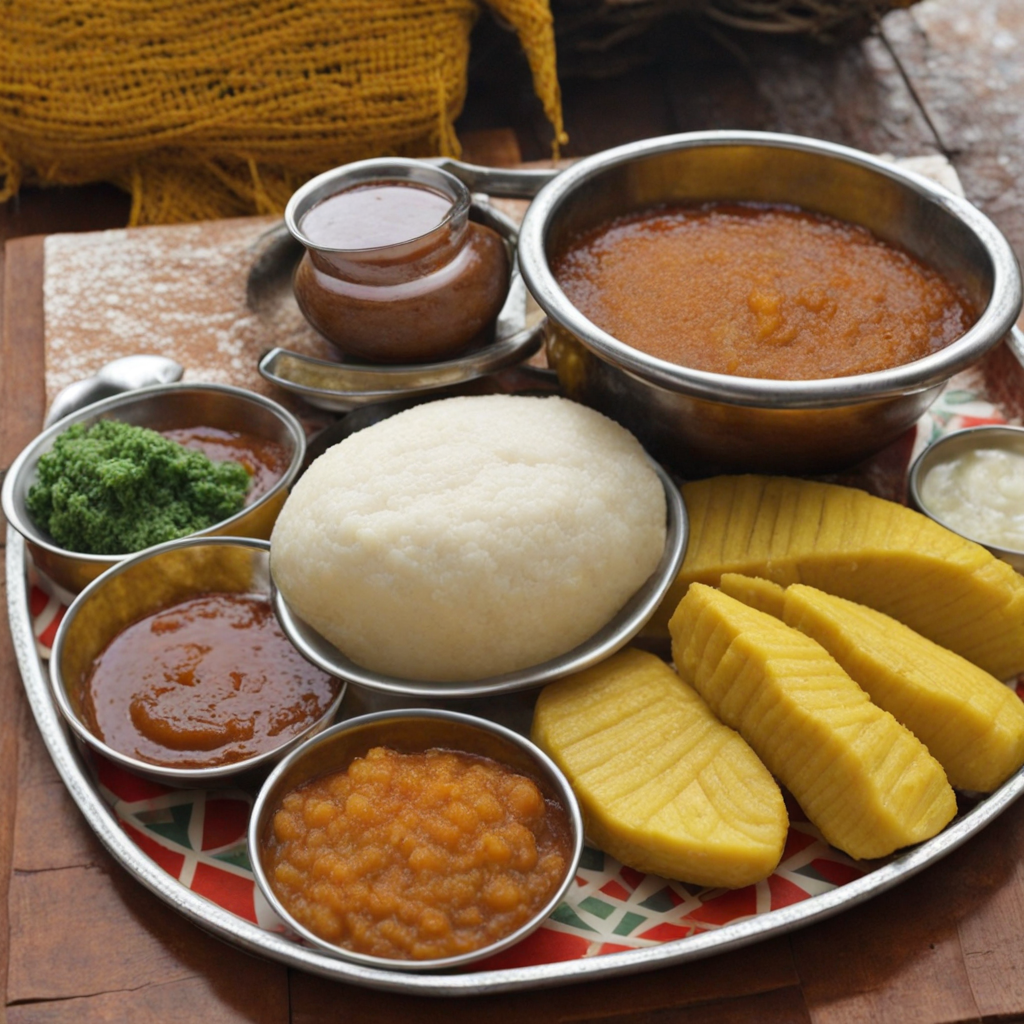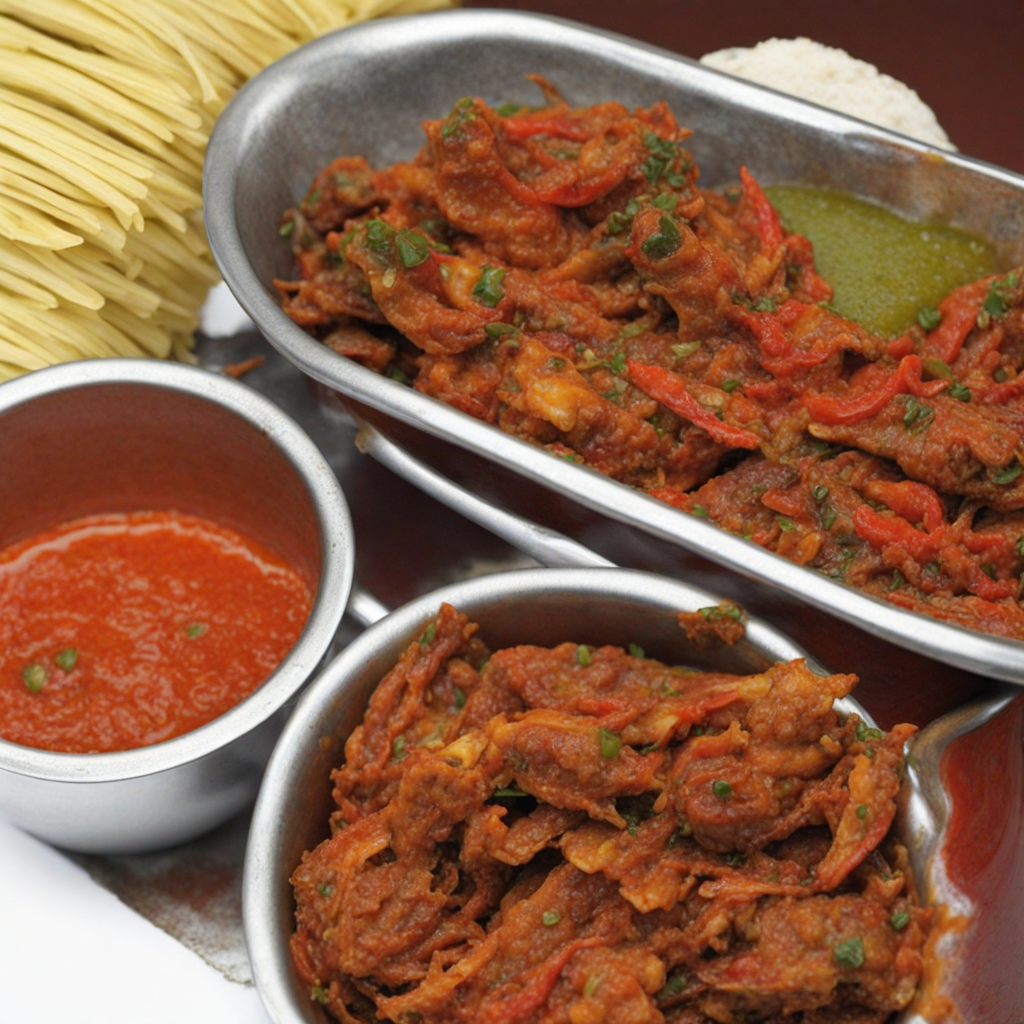Ampesi
Ampesi is a delightful Ghanaian dish that primarily consists of boiled yam or plantains, often accompanied by a rich, savory sauce or stew. The dish is celebrated for its simplicity and heartiness, making it a staple in many Ghanaian households. The yams or plantains are typically peeled, cut into manageable pieces, and boiled until they reach a tender, fluffy consistency. This method of preparation allows the natural flavors of the tubers to shine through, providing a comforting base for the accompanying sauces. What truly elevates Ampesi is the variety of sauces that can be paired with it. One popular option is a spicy pepper sauce made from fresh tomatoes, onions, and chili peppers, which adds a zesty kick to the dish. Additionally, groundnut (peanut) stew is another frequent companion, offering a creamy, nutty flavor that complements the starchy base perfectly. These sauces not only enhance the taste but also provide a burst of color and texture, creating a visually appealing meal that is as satisfying to the eyes as it is to the palate. Ampesi is often enjoyed as a communal dish, bringing family and friends together around the table. It embodies the essence of Ghanaian cuisine, which emphasizes sharing and togetherness. Whether eaten during festive occasions or as a comforting everyday meal, Ampesi offers a unique culinary experience that introduces newcomers to the rich flavors and traditions of Ghanaian food culture. Each bite is a journey through the vibrant tapestry of Ghana, making it a must-try for anyone seeking to explore new tastes.
How It Became This Dish
The Rich History of Ampesi: A Culinary Treasure of Ghana Ampesi, a traditional Ghanaian dish, holds a special place in the hearts and homes of many Ghanaians. This staple food, typically made from boiled yam, plantains, or cassava, is often served with a variety of flavorful sauces and stews. Its origins, cultural significance, and evolution over time reflect the rich tapestry of Ghanaian culinary traditions and the interplay of geography, agriculture, and society. Origins of Ampesi The roots of Ampesi can be traced back to the indigenous peoples of West Africa, where yam, plantains, and cassava have been cultivated for thousands of years. Yams, in particular, are believed to have been domesticated in West Africa around 3000 B.C. They thrive in the region's tropical climate and are a key agricultural product, making them a staple in the diets of many Ghanaian communities. The Akan people, one of the largest ethnic groups in Ghana, have a profound connection to yam cultivation. It is often regarded not just as food but also as a symbol of wealth and prosperity. Traditionally, the first yam harvested in the season is celebrated with festivals, marking the beginning of the yam harvest and reflecting the cultural importance of this tuber in Ghanaian society. Plantains and cassava, both integral components of Ampesi, also have deep roots in Ghanaian agriculture. Plantains, which are often mistaken for bananas, are versatile and can be prepared in various ways, while cassava serves as a critical source of carbohydrates in the Ghanaian diet. Together, these ingredients form the foundation of Ampesi, showcasing the agricultural diversity of the region. Cultural Significance Ampesi is much more than just a meal; it is emblematic of Ghanaian hospitality and communal living. In many Ghanaian homes, the preparation and sharing of Ampesi signals an occasion for gathering family and friends. The dish is often served during celebrations, festivals, and communal feasts, highlighting its role in social bonding and cultural identity. The communal aspect of Ampesi is reflected in its preparation. Traditionally, families would come together to harvest yams, plantains, or cassava, and the cooking process often involved collaboration. This communal cooking fosters relationships and reinforces the importance of family ties. The dish also carries significant cultural and spiritual meanings. In some communities, the first serving of Ampesi is often reserved for elders as a mark of respect. The act of sharing food, especially during important ceremonies, is deeply ingrained in Ghanaian culture, representing unity and mutual support. Development Over Time As Ghanaian society has evolved, so too has the preparation and consumption of Ampesi. Historically, it was prepared using simple methods reflecting the agrarian lifestyle of the people. Yams and plantains would be peeled, boiled, and served with local sauces made from groundnuts (peanuts), tomatoes, peppers, and other ingredients available in the region. Each community often had its unique twist on the sauce, resulting in a variety of flavors and styles. With the advent of modernity and globalization, the preparation of Ampesi began to incorporate new influences. Urbanization brought about changes in lifestyle and dietary habits. The influx of new cooking techniques and ingredients led to a fusion of traditional and contemporary culinary practices. For instance, the use of electric cookers and pressure cookers has simplified the cooking process, reducing the time and effort required to prepare Ampesi. Additionally, the growing influence of international cuisine has led to innovative interpretations of the dish. Chefs and home cooks alike have started experimenting with Ampesi, pairing it with different sauces, proteins, and side dishes to create unique culinary experiences. While this evolution has introduced new flavors, many still hold on to traditional recipes, believing that the authenticity of Ampesi should be preserved. Furthermore, Ampesi has become a symbol of Ghanaian identity on the international stage. As Ghanaian cuisine gains recognition globally, Ampesi is often featured in cultural festivals and food exhibitions, showcasing the rich culinary heritage of the nation. The dish's simplicity, coupled with its versatility, makes it an excellent ambassador for Ghanaian food culture. Ampesi in Modern Ghana Today, Ampesi remains a beloved dish across Ghana, enjoyed by people of all ages and backgrounds. It is commonly prepared at home but is also a staple in restaurants and street food stalls, making it accessible to both locals and tourists. Its presence in urban centers has led to the emergence of variations that cater to contemporary tastes, such as serving it with grilled or fried fish, chicken, or even exotic sauces that infuse global flavors. The dish is often accompanied by a traditional Ghanaian pepper sauce known as "shito," a spicy condiment made from dried fish, peppers, and spices. This pairing not only enhances the flavor of Ampesi but also reflects the intricate balance of spices that characterize Ghanaian cuisine. The combination of textures and flavors provides a satisfying culinary experience that resonates with many. Moreover, Ampesi has a significant role in Ghanaian health and nutrition. As a carbohydrate-rich dish, it provides energy and sustenance, making it an essential part of the daily diet. The nutritional value of the ingredients used in Ampesi is further complemented by the variety of sauces that can be paired with it, which often include vegetables and proteins. Conclusion In conclusion, Ampesi is a culinary gem of Ghana, steeped in history and cultural significance. Its origins in ancient agricultural practices, coupled with its role in fostering community and social bonds, make it a dish that transcends mere sustenance. As it continues to evolve in the modern culinary landscape, Ampesi remains a testament to the rich heritage of Ghanaian cuisine, celebrating the past while embracing the future. Whether enjoyed during festive occasions or as a daily meal, Ampesi embodies the spirit of Ghana, reflecting the warmth and hospitality of its people.
You may like
Discover local flavors from Ghana







